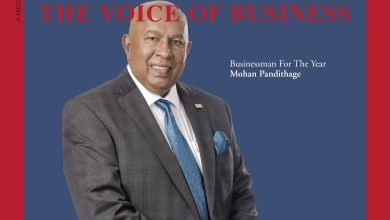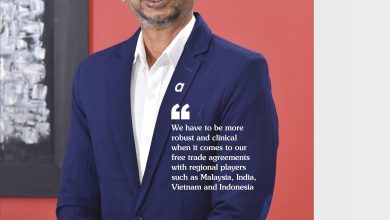THE YEAR IN REVIEW
Holding strong in a meltdown
BY Ruchi Gunewardene, Aliakber Alihussain, Dhanushika Shanmuganathan and Melani Jesuthasan
As countries across the world find themselves under significant stress – first managing the ebb and flow of COVID-19, and now the fallout from the global economic crisis – businesses are compelled to adapt through what has become a tumultuous decade so far.
Meanwhile in Sri Lanka, the economic debacle has put businesses and brands under immense pressure. Sky-high interest rates, high inflation and dwindling consumer disposable incomes have resulted in dramatic changes to the basket of goods being purchased.
Businesses that have built reputations and garnered recognition through their brands however, are in a much better position to weather the storm. This is because customers are seeking assurances and stability in their everyday brand purchases – rather than experimenting with the unfamiliar except in the case of cutting costs.
In the midst of this meltdown, only the strongest and most innovative brands will survive. This year’s review has been undertaken in what can arguably be said to be the most tumultuous in the history of the country since gaining independence more than 75 years ago.
CHALLENGES TO ENDURE The economic prescription being adopted to stabilise the economy will separate the resilient from the weak. This makes managing brands under tough economic conditions very different to doing so in normal conditions.
Brand Finance’s research and financial analysis can help in making critical business decisions, such as in which brands in the portfolio investment should be increased and which ones should be withdrawn, optimising marketing investments, opportunities to reposition or relaunch a brand in the light of shrinking markets and declining purchasing power.
As the margin of error reduces during these volatile times, getting it right is crucial for business survival. Our review must lead brands to work out how to rebuild consumer confidence, thereby improving business stability, reducing risk and outperforming competitors to earn more.
TOP LINE RESULTS This year, Brand Finance’s top 100 Sri Lankan brands has seen a massive decrease of 16 percent in cumulative brand value. This decline in value reflects the multiple macroeconomic issues that brands had to endure during the last financial year as well as the challenges they will have to endure in the coming years.
The pole position as the most valuable brand in the index in these tumultuous times is once again retained by Dialog with a brand value of Rs. 52 billion. Despite its brand value declining by four percent, Dialog’s retention of its leadership in the rankings is underpinned by the well-coordinated delivery of innovative and affordable service packs, a superior network and customer experiences amid a challenging business environment.
Banking brands continue to dominate the top 100, accounting for 52 percent of the aggregate brand value.
SECTOR OVERVIEW While most sectors within Sri Lanka’s top 100 recorded a decline in overall brand value, insurance brands registered the largest decrease.
The insurance sector was greatly influenced by reduced disposable incomes because of inflationary pressures, the rupee depreciation and tax reforms – all of which had a negative impact on demand and the capacity to pay premiums.
For the third year in a row, the March 2020 vehicle import ban undermined the expansion of the general insurance sector. The capacity to remit reinsurance premiums was hampered by the foreign exchange liquidity crisis and some reinsurers withdrew from the market because of sovereign downgrades.
The banking sector, which has long been the backbone of the nation’s economic might, also absorbed a decline of nine percent in aggregate brand value. Despite this however, the sector emerged as one that was able to better withstand the impacts of macroeconomic pressures, both in terms of value and strength.
Banking brands are inextricably interwoven across the socioeconomic fabric of the country; and those that rapidly focussed on supporting the revival of businesses and communities in the face of the crisis reaped benefits.
WINNING BRANDS Dialog retains its position as the most valuable brand in Sri Lanka for the fifth consecutive year. It is closely followed by BOC with a difference of 1.8 billion rupees.
Commercial Bank and People’s Bank retain their spots as the third and fourth most valuable brands respectively. In the meantime, Sampath Bank takes a leap of three places, entering the top five in Sri Lanka’s 100 most valuable brands for 2023.
Dialog continued to report robust financials despite the challenges faced by the nation. The brand accelerated its digital transformation agenda, continuing to deliver services, and support its customers, businesses, communities and the nation at large.
It also reclaims the title of strongest brand in the 2023 Sri Lanka rankings from Keells, which was last year’s numero uno, with a Brand Strength Index (BSI) score of 91 out of 100 and brand rating of ‘AAA+.’
Sampath Bank’s entry into the top five with a brand value of Rs. 25.7 billion was driven by the brand’s strong financial performance despite the incessant market and operational disruptions. The bank’s swift movement in its strategic reorientation to enable it to adapt to the highly uncertain economic conditions has been a key factor in the brand’s climb up the rankings.

BANKING SECTOR The banking sector faces significant challenges due to the restructuring of sovereign debt, the high interest rate environment and tax adjustments in addition to the economic crisis.
Despite the challenging environment, the sector continues to be the country’s most valuable, accounting for 47 percent of the total value of the top 100 brands.
BOC continues to be the most valuable banking brand, valued at 50.2 billion rupees (though its brand value decreased by 7% from last year). Bank of Ceylon’s leadership as a banking brand is fuelled by its strong positioning as a state bank whose focus over the last year was on the revival and rehabilitation of businesses.
The bank’s timely decision to extend strategic support to customers through the restructuring and rescheduling of debt enabled several impacted sectors and businesses to cope with the multiple crises. This is also reflected in the brand’s ‘AAA’ rating within the index.
Commercial Bank retains the title of the strongest banking brand with a score of 88 out of 100 and corresponding ‘AAA’ strength rating. It continues to tout exceptional performance as Sri Lanka’s largest private sector bank, and has built a strong legacy as one of the most recognised Sri Lankan banks both locally and internationally.
However, it is noteworthy that BOC trails behind Commercial Bank by only a small margin in terms of brand strength.
SUPERMARKETS SECTOR After a continuous downfall due to the Easter Sunday bombings in April 2019 and general uncertainty linked to elections followed by the onset of the pandemic in 2020, the supermarkets sector returned to positive growth last year.
In the year under review however, supermarkets were up against the wall yet again due to increasing costs, constricting margins and the unavailability of goods. Inflation rose to above 50 percent, and consumers shifted away from supermarkets – they preferred general trade stores as the economy worsened.
The nation’s major supermarkets experienced a decline in brand value in Brand Finance’s 2023 Sri Lanka 100 rankings.
Keells dropped in value by 36 percent and is currently valued at Rs. 17.7 billion while Cargills Food City overtook it in terms of value – by registering a brand value of 18.9 billion rupees (though it absorbed a decline of 18%). Galloping inflation and high costs meant that consumers were hard pressed.
While both brands recorded declines in brand strength, Cargills Food City’s stronger revenue base provides the brand with a competitive advantage to withstand the impact of the economic crisis. Boasting a presence in all 25 districts, it opened its 500th outlet in 2022.
Furthermore, the brand’s improving productivity in operations, and exploration of alternatives to items as imported food continues to rise in price and become scarce, can be key factors in the brand’s overall performance this year.
It’s also noteworthy that Lanka Sathosa surpassed Arpico Supercentre – possibly due to being a government organisation and therefore, able to offer goods at discounted prices compared to other supermarkets.
INSURANCE SECTOR As a result of the hardships that the sector faced, the brand value of general insurance brands in Sri Lanka’s top 100 witnessed a year on year contraction of 32 percent with most showing a double digit drop in brand value on a year on year basis.
The exception to this is LOLC General Insurance, which recorded a 35.4 percent growth in brand value. Active participation through innovative insurance solutions throughout the epidemic enabled it to enhance brand familiarity, promotion and consideration.
Despite the challenging environment, Sri Lanka Insurance General retains its position as the leading general insurance provider with a brand value of Rs. 3.1 billion. It is closely followed by Ceylinco General Insurance, which achieved a brand value of 2.3 billion rupees.
In comparison to the pandemic affected 2020 financial year, most life insurance brands’ net earned premiums (NEP) began recovering in the following two years.
Life insurance players like Softlogic Life made changes to product mixes, given the fact that substantial increases in policy rates during the year and currency depreciation had major adverse impacts on business. They changed their product portfolios to focus on more investment-based products to capture the lost share of revenue.
Irrespective of the notable growth in NEP and profitability, life insurance brands in the Sri Lanka top 100 saw a 22 percent year on year drop. This was mainly because of the strength of the brands recording a decrease year on year with consumers facing immense economic hardships.
This in turn led to life insurance being seen as somewhat of a luxury purchase as people continue to make payments to avoid future negative impacts on their policies.
In line with this, our market research has shown that brands are being perceived negatively this year along with a drop in consideration.
Ceylinco Life Insurance retains its position as the No. 1 brand in the life insurance segment with the lowest decline in brand value (9% compared to the previous year). In fact, it surpasses Sri Lanka Insurance General to be the most valuable brand in the insurance sector.
Life insurance penetration in Sri Lanka remains low at roughly 0.6 percent – well behind that of regional peers. Coming out of the most recent crisis, brands have the opportunity to continue to grow their businesses.
FUTURE CHALLENGES In times of great uncertainty and limited budgets, marketing management needs to be much more accountable. This requires very strong controls and a comprehensive dashboard to track performance while carefully selecting investments with the greatest returns.
While a cutback in budgets is expected, marketing management needs to find new and innovative ways of engaging customers. Greater impacts with smaller budgets is the need of the hour.
In these times, it is particularly important to also understand customer sentiment, and proactively help make their lives a little easier as the economy strives to come out of the economic debacle and regain growth, which is expected only in 2024.






